Egyptian Gods of Ennead
- Details
- Written by AndEl
Egyptian Gods of Ennead
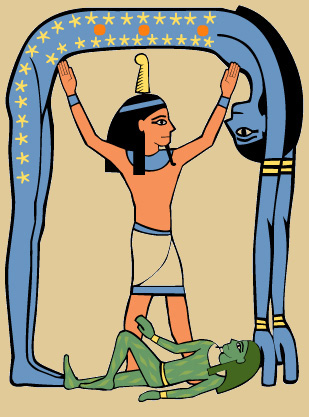
Then Ra came into existance, born from a lotus flower that emerged from the waters. He spat out Tefnut; The goddess of moisture, and Shu; the God of air. He had nowhere to stand so he called upon a mound of earth to rise up from the depths of Chaos, and the first spot of land appeared before him. This place would become Egypt, and all the land around it would become the other continents.
On this Land Tefnut and Shu had 2 children named Nut and Geb. Ra then proclaimed that Geb would be the god of the earth and Nut would become the Goddess of the sky.
Geb and Nut fell in love with each other and soon the sky and the earth became connected. Ra became angered at what Nut and Geb had done so he sent Shu down to separate them. Although he succeeded in separating Geb and Nut, Nut became pregnant and would give birth to the 4 deities that would complete what would now become the "Ennead" of Gods. From the Ennead all other Egyptian Gods would form. For now, the world would be complete....
Egyptian Gods of Ennead
The group of the nine chief deities of the Osirian cycle in ancient Egyptian myth. They are Atum, Shu, Tefnut, Seb, Nut, Osiris, Isis, Seth, and Nephthys.
The term is also frequently used in Egyptian texts to denote the divine council of gods and goddesses in general.
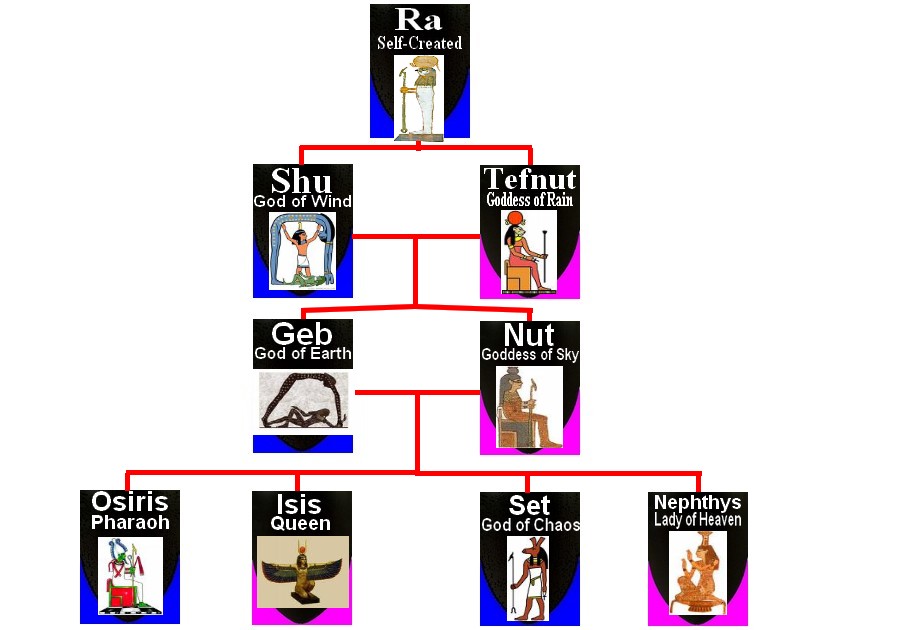
Atum
The primeval Egyptian sun god and creator of the world. He is the evening aspect of the sun, representing the setting sun. Later he was syncretized with Re as the god Atum-Re. According to the myths, he was the first substance (a hill) who emerged from the primeval waters. Amut created the deities Shu and Tefnut from his spittle or from his semen in the act of masturbation.
Atum was especially worshipped at Heliopolis, where he was the head of the Ennead cult. He was represented by the black bull Mnewer, who bore the sun disk and uraeus between its horns. As the father of the pharaoh, he played an important part in the coronation rites. Atum was depicted as old man symbolizing the setting sun, but he also appeared also a snake, a scarab, and a mangust (pharaoh hat). The snake, bull, lion, lizard and ichneumon are his sacred animals.
The Memphite creation myth stated that Atum was conceived in the heart of Ptah and was created by his word. Literally, "he who completes, or perfects".
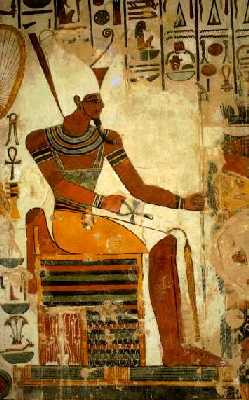
Re
The most important of the Egyptian gods, the personification of the (midday) sun. According to the Heliopolitan cosmology he created himself from a mound that arose from the primeval waters of Nun or out of a primordial lotus flower. He then created Shu (air) and Tefnut (moisture), who in turn engendered the earth-god Geb and the sky-goddess Nut. Re was said to have created humankind from his own tears and the gods Hu and Sia from blood drawn from his own penis.
The sun itself was taken to be either his body or his eye (the 'Eye of Re'). The center of his cult was from the very beginning in Heliopolis, where he was also venerated in the forms of Atum (the setting sun) and Khepri (the rising sun) and, in connection to the morning sun, as Re-Harachte. As Re-Atum he is the creator who gives light and warmth and thus growth. Re was often combined with other deities to enhance the prestige of the latter, as in Re-Atum or Amun-Re.
It was said that Re traveled each day in his solar barque through the sky, starting in the morning. At night, Re journeyed through the underworld in another barque. And each night, the monster Apep would try to prevent the sun-god from emerging again: the eternal battle between light and darkness. The gods Seth and Mehen accompanied him and were often depicted defending Re's barque. Others believed that Re could be found at night in the underworld, consoling and giving support to the dead. Re is also the god of the pharaohs and since the fourth dynasty the Egyptian kings styled themselves 'sons of Re'. After death, the monarch was said to ascend into the sky to join the entourage of Re.
In Heliopolis the Benu or Phoenix (sacred heron) and the oracular Mnevis (bull) were venerated as manifestations of the sun-god. Here the kings also built temples for Re, which were important institutions in the field of ideology. Re was usually portrayed as a man with the head of a falcon, crowned with the sun disc encircled by the uraeus.
Shu
The embodiment of the sky. In the Ennead of Heliopolis he is the son of Atum and brother-husband of Tefnut. He was one of the first deities to be created by Atum, either from his semen or the muscus of his nostrils. With Tefnut he became the father of Nut (the sky) and Seb (the earth). He raised the body of his daughter high above the earth and separated thus heaven and earth.
The connection of Atum and Re, as Atum-Re, makes Shu a 'son of Re' and as such the brother of the Egyptian king (who calls himself a 'son' as well. Shu is depicted in human form wearing an ostrich feather (the hieroglyph for his name), with his arms raised to support Nut above the supine form of her brother Geb.
Tefnut
The personified goddess of moisture in Egyptian mythology. Together with her consort Shu (Air) she was produced by Re from his own body by masturbation. By Shu she became the mother of Seb (Earth) and Nut (Sky).
Seb
As the son of Shu and Tefnut, Seb was the Egyptian earth god. He was masculine, contrasting with the tradition that the guardian of the earth was usually female. Osiris, Isis, Seth, and Nephthys were his children and he was brother and husband to Nuit. In early Egyptian history, Seb was known as Geb or Keb, but in later forms of the language it became Seb. Seb's sacred animal and symbol was the goose; he was often referred to as the "Great Cackler." His skin was either green or black. The green represented the color of living things and the black was the color of the fertile Nile mud. It was believed that Seb imprisoned wicked souls, so they couldn't ascend to heaven.
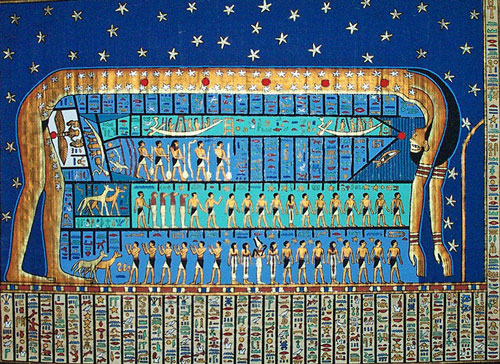
Nut
The ancient Egyptian sky-goddess, one of the Ennead of Heliopolos. She is the personification of the sky and of the heavens, the daughter of Shu and Tefnut.
Nu was the barrier separating the forces of chaos from the ordered cosmos in this world. The god Re was said to enter her mouth after setting in the evening and travel through her body during the night to be reborn from her vulva each morning. She also swallows the stars and have them reborn later. In the death cult she plays a part in the resurrection of the dead; she is portrayed on the inside of the lids of the sarcophagi. The pharaoh was said to enter her body after death, from which he would later be resurrected.
As sky-goddess Nut was portrayed as a naked woman covered with painted stars, held up by Shu. Thus she forms the firmament above her husband Seb, the earth. Her fingers and toes were believed to touch the four cardinal points or directions. The principal sanctuary of Nut was at Heliopolis.
Hu
In Egyptian mythology the creating word of the sun-god of Heliopolis, personified in the same god. With Sia he forms a primeval pair, both born from a drop of blood from the penis of Re, and together they personify the insight and wisdom of the sun-god. They also accompany him on his solar barque and help the bring order in chaos. When the pharaoh became a lone star, his companion was Hu.
Sia
A primeval Egyptian god personifying the mind. She was born from a drop of blood from the penis of Re. Her consort is Hu.
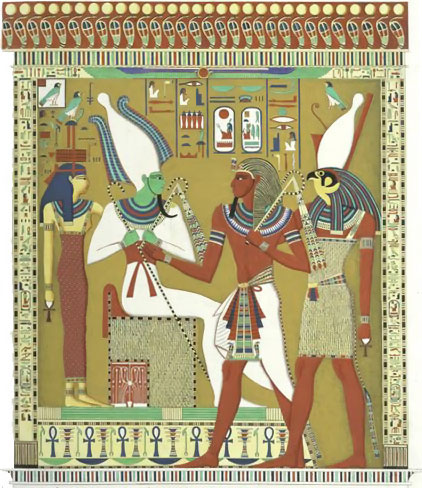
Osiris
Osiris was the Egyptian god of the underworld, although he was also worshipped as a fertility, resurrection, and vegetation god. He was married to Isis, a sky goddess. He was father to Horus, the god of sky, and protector of the dead.
Osiris was killed by his brother Seth, who shut his body in a chest and threw it into the Nile, where it washed up onto the shore and was trapped in a huge tree. The King Byblos turned it into a pillar in his palace. Isis (who had been searching for her husband) discovered the trunk, and retrieved the trunk and the body. While Isis was away, Seth found the body, and chopped it up into many pieces, and scattered them throughout Egypt. Isis and her sister, Nephthys, found the pieces and made wax models of them to give to priests to be worshipped. When they found all of his pieces, they were so sad they wailed loudly enough for Re, the father god, to have pity on them. He sent Anubis and Thoth to help. They mummified Osiris, and put his body in a lion headed pier. Isis changed into a kite and fanned breath into Osiris.
He was not allowed to stay in the land of the living, and was sent to the underworld to serve as king, and to judge the souls of the dead.
Isis
One of the most popular goddesses in Egypt. Isis belongs to the Ennead of Heliopolis, and according to the Heliopolitan genealogy is a daughter of Seb and Nut, sister and wife of Osiris. Possibly she was originally the personification of the throne (her name is written with the hieroglyph for throne), and as such she was an important source of the pharaoh's power. In the Hellenistic time Isis was the protectress of sailors.
In the Osiris myths she searched for her husband's body, who was killed by her brother Seth. She retrieved and reassembled the body, and in this connection she took on the role of a goddess of the dead and of the funeral rights. Isis impregnated herself from the Osiris' body and gave birth to Horus in the swamps of Khemnis in the Nile Delta. Here she raised her son in secret and kept him far away from Seth. Horus later defeated Seth and became the first ruler of a united Egypt. Isis, as mother of Horus, was by extension regarded as the mother and protectress of the pharaoh's. She was worshipped as the divine mother-goddess, faithful consort of Osiris, and dedicated mother of Horus.
Isis was depicted as a woman with the solar disk between the cow horns on her head (an analogy with the goddess Hathor) or crowned with a thrown, but also with the child Horus sitting on her lap. A vulture was sometimes seen incorporated in her crown. Also she was sometimes depicted as a kite above the mummified body of Osiris. Isis' popularity lasted far into the Roman era. She had her own priests and many temples were erected in her honor. On the island of Philae in the Nile delta her largest temple was situated (it was transferred to the island Agilkia in 1975-1980).
The name Isis was understood by Plutarch as meaning 'Knowledge'.

Seth
The ancient Egyptian god of chaos, the embodiment of hostility and even of outright evil. He is also a god of war, deserts, storms, and foreign lands. As the god of deserts he protects the caravans which travel through the desert, but he also causes sandstorms which bring him into conflict with the fertility god Osiris. The two are adversaries and in the Osiris myths, Seth killed his brother and scattered the remains all over Egypt. Seth belongs to the Ennead of Heliopolis and is the son of Geb and Nut (or Re and Nut). He is the brother of Osiris, Isis, and Nephthys, who is sometimes given as his consort, although Seth is more commonly associated with the foreign, Semitic goddesses Astarte and Anat. During the 3rd millennium BCE Seth replaced Horus as the tutelary deity of the pharaohs, but the story of Osiris' murder gained currency and Horus was restored to his original status. The war that followed lasted eighty years, during which Seth tore out Horus' left eye and Horus tore off Seth's foreleg and testicles. Eventually, Horus emerged victorious, or was deemed the victor by the council of the gods, and thus became the rightful ruler of the kingdoms of Lower and Upper Egypt. Seth was forced to return the eye of Horus and was either castrated or killed. In other versions he went to live with the sungod Re, where he became the voice of thunder. In the Book of the Dead, Seth is called "Lord of the Northern Sky" and is held responsible for storms and cloudy weather.
Despite his reputation, Seth has some good characteristics. He protects the sun barge of Re during its nightly journey through the underworld and he fights the snake-like monster Apep. On the other hand, he was a peril for ordinary Egyptians in the underworld, where he was said to seize the souls of the unwary.
Seth was portrayed as a man with the head of undeterminable origin, although some see in it the head of an aardvark. He had a curved snout, erect square-tipped ears and a long forked tail. He was sometimes entirely in animal form with the body similar to that of a greyhound. Animals sacred to this god where the dog, the jackal, the gazelle, the donkey, the crocodile, the hippopotamus, and the pig. There was an important sanctuary at Ombos in Upper Egypt, his reputed birthplace, and considered to be the home of his cult. This cult was also prominent in the north-eastern region of the Nile delta. The Greeks equated him with their Typhon.
Other names include Sutekh, Setech, and Sutech.
Nephthys
The "Mistress of the House" (Nebet-het or Nebt-het in the Egyptian Language), Nephthys is the "Friend of the Dead," and is first mentioned in Old Kingdom funerary literature as riding the "night boat" of the underworld, meeting the deceased king's spirit and accompanying him into "Lightland." Her hair is metaphorically compared to the strips of cloth which shroud the bodies of the dead.
Nephthys is almost universally depicted as a woman with the hieroglyphic symbols of her name (a basket and a house, stacked on top of each other) situated atop her head, though she can also be depicted as a bird (most often a kite or some other form of falcon/hawk). She was associated with funerary rituals throughout ancient Egyptian history and was venerated not as Death itself, but as the companion who gives guidance to the newly deceased, and as a Lady With Wings who comforts the deceased's living relatives. Nephthys is in most myths the youngest daughter of Nut, sister of Isis and Osiris and the sister-consort of Seth. In later periods Nephthys is also considered to be the mother of Anubis, a primordial form of the lord of the dead who later became subservient to Osiris in the Egyptian cultic myth.
Nephthys had connections with life as well as death -- she stood at the head of the birth-bed to comfort and assist the mother giving birth (while her sister, Isis, stood at the foot to midwife the child).
To our current Egyptological knowledge, Nephthys did not have her own cult or temples in Egypt until the Ptolemaic-Roman period; however, as her name is merely a title (the same title given to the eldest woman in any ancient Egyptian household), it is possible that Nephthys may be a specialized form of another goddess; probable candidates include Bat (as she is called the "Lady of Het," or "Nebt-het") and Neith (with whom Nephthys is paired in the canopic shrine quadrants, as Isis is with Serket, who is sometimes seen to be an aspect of Isis.
Neith's being the "eldest of goddesses," along with her connection with weaving and funerary garments lends credence to this theory, as does the interchangeable depiction of Neith and/or Nephthys in symmetrical transposition on a number of Late Period temples.
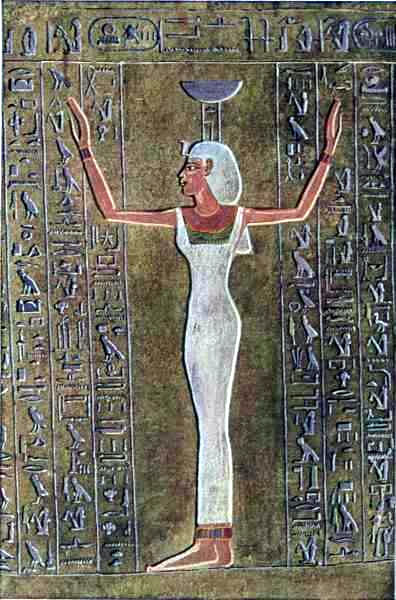
Horus
The name "Horus" is a general catchall for multiple deities, the most famous of whom is Harseisis (Heru-sa-Aset) or Horus-son-of-Isis (sometimes called Horus the Younger) who was conceived after the death of his father, Osiris, and who later avenged him. In all the Horus deities the traits of kingship, sky and solar symbology, and victory reoccur. As the prototype of the earthly king, there were as many Horus gods as there were rulers of Egypt, if not more.
The oldest of the Horus gods is appropriately named Horus the Elder (Heru-ur), and was especially venerated in pre-Dynastic Upper Egypt along with Hathor. In this very ancient form, Horus is also a creator god, the falcon who flew up at the beginning of time. The pre-Pharaohnic rulers of Upper Egypt were considered "shemsu-Heru" or "followers of Horus", and the original Horus is himself considered in some myths to be the brother of Seth and Osiris, second-born of the five children of Geb and Nut (Osiris, Horus, Seth, Isis, Nephthys). Horus the Elder's city was Letopolis, and his eyes were thought to be the sun and moon. When these two heavenly bodies are invisible (as on the night of the new moon) he goes blind and takes the name Mekhenty-er-irty, "He who has no eyes". When he recovers them, he becomes Khenty-irty, "He who has eyes". A warrior-god armed with a sword, Horus could be especially dangerous to those around him in his vision-deprived state, and during one battle in particular he managed to not only knock off the heads of his enemies but of the other deities fighting alongside him, thus plunging the world into immediate confusion that was only relieved when his eyes returned.
Other notable Horus gods are the previously mentioned Harseisis, as well as Horus of Behdet (sometimes called simply Behdety) who was represented as a winged sun disk, Anhur (a form of Horus the Elder and Shu), Horakhety (Ra-Heru-akhety) who was a syncretism of Ra and Horus, and Harpokrates (Heru-pa-khered) or Horus the Child. In the form of Harpokrates, Horus is the danger-beset son of Isis with one finger to his lips, signifying his childish nature (also evident in his princely sidelock and naked status). Harpokrates represented not only the royal heir, but also the newborn sun.
Horus deities are frequently depicted as hawks or hawk-headed men, though some are represented as fully human. The pharaoh was considered to be the Living Horus, the temporal stand-in for Horus in the earthly domain. As the opponent of Seth (who, though initially an Upper Egyptian deity himself, later came to represent not only Lower Egypt but the desert surrounding Egypt), Horus is alternately a brother vying for the throne and unification of Egypt (Horus the Elder), or a royal heir come to reclaim his inheritance (Horus the Younger).
Horus can be seen at the top of the serekh of early kings, though in very rare cases his place was usurped by Set (Peribsen, Dynasty 2) or even shared with him (Khasekhemwy, Dynasty 2). Horus is also depicted on the famous Narmer palette along with Bat, an earlier form of Hathor.
A passage from the Coffin Texts (passage 148) sums up Horus in his own words:
"I am Horus, the great Falcon upon the ramparts of the house of him of the hidden name. My flight has reached the horizon. I have passed by the gods of Nut. I have gone further than the gods of old. Even the most ancient bird could not equal my very first flight. I have removed my place beyond the powers of Set, the foe of my father Osiris. No other god could do what I have done. I have brought the ways of eternity to the twilight of the morning. I am unique in my flight. My wrath will be turned against the enemy of my father Osiris and I will put him beneath my feet in my name of 'Red Cloak'."
"Myth and Symbol in Ancient Egypt" by R.T. Rundle Clark, p. 216
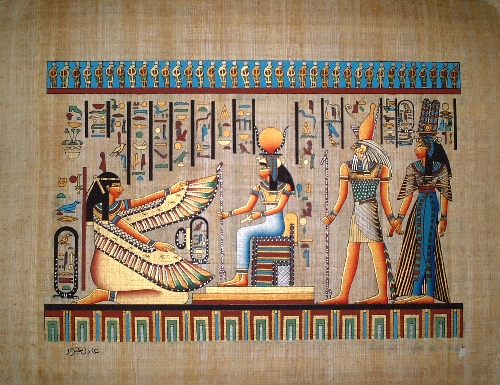
Liked this article? Dive deeper into personal growth and wellness! Check out CrystalWind.ca for spiritual wisdom or explore AromaWorx.ca for natural well-being tips. Spread the positivity—share this with friends on their happiness journey!
Let’s Chat! Drop Your Thoughts Below! ![]()
Latest Articles
Dive into the Mystical World of the Crystal Wind Oracle Deck!
Get All the Enchanting Details Now!
NEW Expanded Boxed Edition!
Now with 58 Cards for Richer Wisdom!

Imagine a world of inspiration and healing, free for all—made possible by YOU!
Donate Now—Ignite the Magic at CrystalWind.ca!

Epilepsy - Finding A Cure
Your donation can make a difference!
Help us find a cure – donate now!
Unlock Your Light: Join Lightworkers Worldwide on CrystalWind.ca!
Articles: Hindu Mythology
Articles: Egyptian Mythology
Articles: Compendium
Follow Us!
Featured This Month
Abalone Shell
Echos Of The Ancestors Abalone strengthens the structure of the body and th... Read more
Chalcedony
The Stone Of Orators Chalcedony was very popular as a decorative stone in ant... Read more
Cancer Mythology
The Mythology of Cancer: A Celestial Tale of Loyalty and Sacrifice Among th... Read more
Lugh - Celtic God Of The Sun
The god Lugh was worshiped in Ireland as a deity of the sun. This connection... Read more
Egyptian Zodiac/Astrology
Egyptian astrology was one of the earliest forms of astrology. The Egyptians w... Read more
Lammas by The Hedgewitch
Although in the heat of a Mid-western summer it might be difficult to discer... Read more
Sun in Cancer
Cancer Sun Sign Characteristics Overview The name "Cancer" comes from Latin, ... Read more













































